warning PORSCHE BOXSTER 2009 2.G User Guide
[x] Cancel search | Manufacturer: PORSCHE, Model Year: 2009, Model line: BOXSTER, Model: PORSCHE BOXSTER 2009 2.GPages: 294, PDF Size: 6.89 MB
Page 23 of 294

Operation, Safety
21
Central Locking in Cars with Alarm
System This device complies with:
Part 15 of the FCC Rules
RSS-210 of Industry Canada.
Operation is subject to the following two condi-
tions:
1. This device may not cause harmful interfer- ence, and
2. this device must accept any interference re- ceived, including interference that may cause
undesired operation.
Note
The manufacturer is not responsible for any radio
or TV interference caused by unauthorized modifi-
cations to this equipment.
Such modification could void the user’s authority
to operate the equipment.
Warning!
Any changes or modificati ons not expressly appro-
ved by Porsche could void the user’s authority to
operate this equipment. f
Please see the chapter “LOAD SWITCH-OFF AF-
TER 2 HOURS OR 7 DAYS” on Page 246.
f Please see the chapter “SEAT MEMORY” on
Page 35.
Both car doors and the fill er flap can be centrally
unlocked or locked with the remote control.
A short signal from the alarm horn will draw
your attention to the fact that the following
components are not completely closed when you
try to lock the vehicle:
– Driver’s door (The vehicle cannot be locked if the driver’s door is not completely closed)
– Passenger’s door
– Luggage compartment lids
– Glove compartment
Unlocking the vehicle by us ing the key in the door
lock and opening the door may activate the alarm
system within 10 seconds. Note
On vehicles with the Sport Chrono Package Plus,
the PCM can be used to activate automatic door
locking.
f
Please see the chapter ”Individual Memory “ in
the separate PCM operating instructions.
Automatic relocking If the car is unlocked by remote control and none
of the car doors is opened within approx.
100 seconds, automatic relocking takes place.
This relocking time can be adapted to your indivi-
dual requirements (10 - 100 seconds) by an autho-
rized Porsche dealer.
Page 26 of 294

24
Operation, Safety
Automatic door locking Your authorized Porsche dealer can program
diverse types of automatic door locking in the
control unit of the central locking system.
Ty p e 1
Doors lock automatically when the ignition is
switched on.
Ty p e 2
Doors lock automatically when a speed of
3 - 6 mph (5 - 10 km/h) is exceeded.
Ty p e 3
Doors lock automatically when the ignition is
switched on. If doors are opened with the engine
running, they lock again automatically when a
speed of 3 - 6 mph (5 - 10 km/h) is exceeded.
Ty p e 4
The doors do not lock automatically. Note
Automatically locked doors can be unlocked with
the central locking button or opened by pulling on
the inside door handle twice.
On vehicles with the Sport Chrono Package Plus,
the PCM can be used to activate automatic door
locking.
f
Please see the chapter ”Individual Memory“ in
the separate PCM operating instructions.
Warning!
In an emergency situation where you need to
exit the car through an automatically locked
door, remember the following procedure to
open the door.
f Unlock the doors by pressing the central
locking button or
f pull the inside door handle twice to open the door.
Fault indication A double horn signal during locking indicates a
defect in the central locking or alarm system.
f Have the defect remed ied at an authorized
Porsche dealer. Overload protection If the central locking system is operated more
than ten times within a minute, further operation is
blocked for 30 seconds.
Page 27 of 294
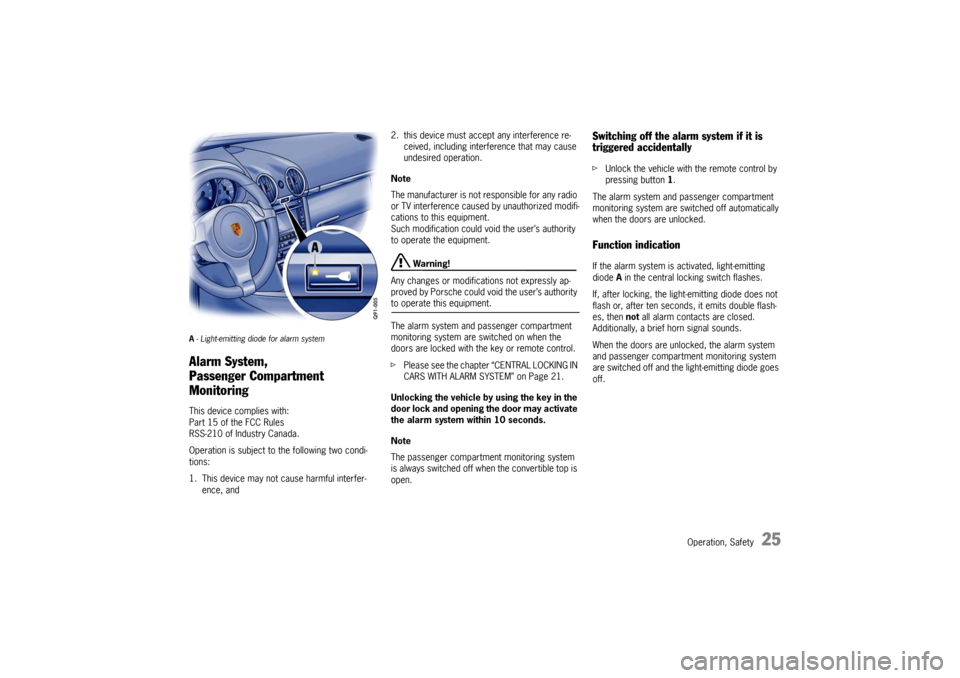
Operation, Safety
25
A- Light-emitting diode for alarm systemAlarm System,
Passenger Compartment
MonitoringThis device complies with:
Part 15 of the FCC Rules
RSS-210 of Industry Canada.
Operation is subject to the following two condi-
tions:
1. This device may not cause harmful interfer- ence, and 2. this device must accept any interference re-
ceived, including interference that may cause
undesired operation.
Note
The manufacturer is not responsible for any radio
or TV interference caused by unauthorized modifi-
cations to this equipment.
Such modification could void the user’s authority
to operate the equipment.
Warning!
Any changes or modifications not expressly ap-
proved by Porsche could void the user’s authority
to operate this equipment.
The alarm system and passenger compartment
monitoring system are switched on when the
doors are locked with the key or remote control.
f Please see the chapter “CENTRAL LOCKING IN
CARS WITH ALARM SYSTEM” on Page 21.
Unlocking the vehicle by using the key in the
door lock and opening the door may activate
the alarm system within 10 seconds.
Note
The passenger compartment monitoring system
is always switched off when the convertible top is
open.
Switching off the alarm system if it is
triggered accidentallyf Unlock the vehicle with the remote control by
pressing button 1.
The alarm system and passenger compartment
monitoring system are switched off automatically
when the doors are unlocked.Function indication If the alarm system is activated, light-emitting
diode A in the central locking switch flashes.
If, after locking, the light- emitting diode does not
flash or, after ten seconds, it emits double flash-
es, then not all alarm contacts are closed.
Additionally, a brief horn signal sounds.
When the doors are unlocked, the alarm system
and passenger compartment monitoring system
are switched off and the light-emitting diode goes
off.
Page 29 of 294
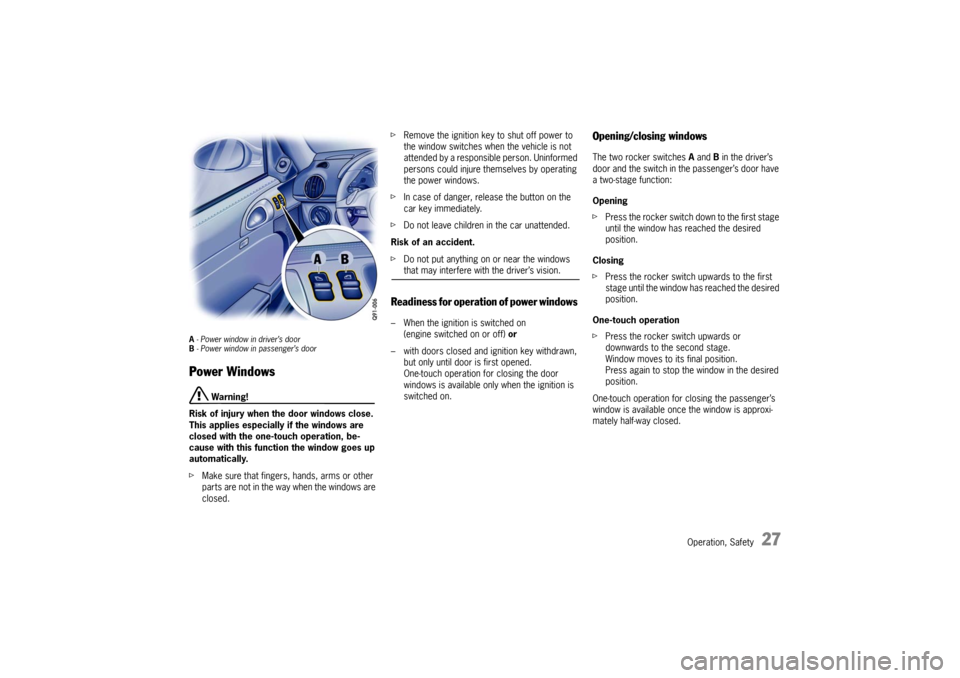
Operation, Safety
27
A - Power window in driver’s door
B - Power window in passenger’s doorPower Windows
Warning!
Risk of injury when the door windows close.
This applies especially if the windows are
closed with the one-touch operation, be-
cause with this function the window goes up
automatically.
f Make sure that fingers, hands, arms or other
parts are not in the way when the windows are
closed. f
Remove the ignition key to shut off power to
the window switches when the vehicle is not
attended by a responsible person. Uninformed
persons could injure themselves by operating
the power windows.
f In case of danger, release the button on the
car key immediately.
f Do not leave children in the car unattended.
Risk of an accident.
f Do not put anything on or near the windows
that may interfere with the driver’s vision.
Readiness for operation of power windows – When the ignition is switched on
(engine switched on or off) or
– with doors closed and ignition key withdrawn, but only until door is first opened.
One-touch operation for closing the door
windows is available only when the ignition is
switched on.
Opening/closing windowsThe two rocker switches A and B in the driver’s
door and the switch in the passenger’s door have
a two-stage function:
Opening
f Press the rocker switch down to the first stage
until the window has reached the desired
position.
Closing
f Press the rocker switch upwards to the first
stage until the window ha s reached the desired
position.
One-touch operation
f Press the rocker switch upwards or
downwards to the second stage.
Window moves to its final position.
Press again to stop the window in the desired
position.
One-touch operation for closing the passenger’s
window is available once the window is approxi-
mately half-way closed.
Page 30 of 294

28
Operation, Safety
Anti-crushing protectionIf a side window is blocked during closing, it will
stop and open again by about an inch.
Warning!
Risk of serious personal injuries.
If the rocker switch is pressed again within
10 seconds of the window being blocked, the
window will close with its full closing force.
Anti-crushing protection is disabled.
f Once the anti-crushing protection acts to stop
the window and opens it slightly, do not press
the rocker switch again within 10 seconds
without checking to make sure that nothing is
blocking the path of the window.The window will close with full closing force.
One-touch operation is disabled for 10 seconds
after blockage of a side window.
Automatic window lowering f Please see the chapter “DOORS” on Page 18.
f Please see the chapter “CONVERTIBLE TOP”
on Page 182.Storing end position of the windowsIf the battery is disconnected and reconnected,
the windows will not be raised automatically when
the door is closed.
1. Close the windows with the rocker switch
once .
2. Press the rocker switch upwards again to store
the end position of the windows in the control
unit.
Page 31 of 294
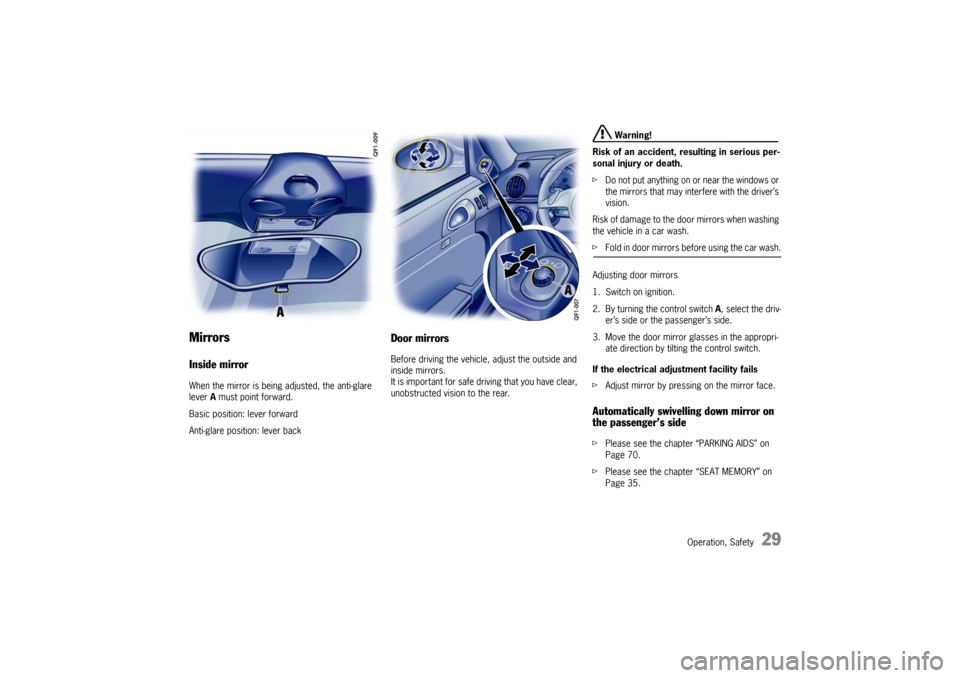
Operation, Safety
29
Mirrors Inside mirrorWhen the mirror is being adjusted, the anti-glare
lever A must point forward.
Basic position: lever forward
Anti-glare position: lever back
Door mirrorsBefore driving the vehicle, adjust the outside and
inside mirrors.
It is important for safe driving that you have clear,
unobstructed vision to the rear.
Warning!
Risk of an accident, resulting in serious per-
sonal injury or death.
f Do not put anything on or near the windows or
the mirrors that may interfere with the driver’s
vision.
Risk of damage to the door mirrors when washing
the vehicle in a car wash.
f Fold in door mirrors before using the car wash.
Adjusting door mirrors
1. Switch on ignition.
2. By turning the control switch A, select the driv-
er’s side or the passenger’s side.
3. Move the door mirror glasses in the appropri- ate direction by tilting the control switch.
If the electrical adjustment facility fails
f Adjust mirror by pressing on the mirror face.Automatically swivelling down mirror on
the passenger’s sidefPlease see the chapter “PARKING AIDS” on
Page 70.
f Please see the chapter “SEAT MEMORY” on
Page 35.
Page 32 of 294
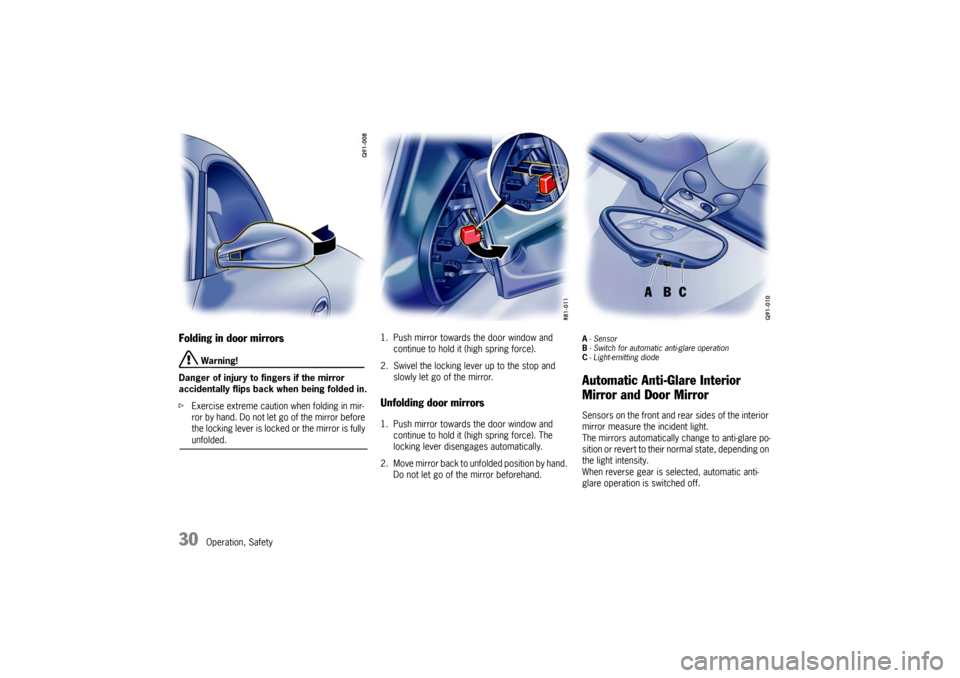
30
Operation, Safety
Folding in door mirrors
Warning!
Danger of injury to fingers if the mirror
accidentally flips back when being folded in.
f Exercise extreme caution when folding in mir-
ror by hand. Do not let go of the mirror before
the locking lever is locked or the mirror is fully unfolded. 1. Push mirror towards the door window and
continue to hold it (high spring force).
2. Swivel the locking lever up to the stop and slowly let go of the mirror.
Unfolding door mirrors1. Push mirror towards the door window and continue to hold it (high spring force). The
locking lever disengages automatically.
2. Move mirror back to unfolded position by hand. Do not let go of the mirror beforehand.
A-Sensor
B - Switch for automatic anti-glare operation
C - Light-emitting diode Automatic Anti-Glare Interior
Mirror and Door Mirror Sensors on the front and re ar sides of the interior
mirror measure the incident light.
The mirrors automatically change to anti-glare po-
sition or revert to their normal state, depending on
the light intensity.
When reverse gear is selected, automatic anti-
glare operation is switched off.
Page 33 of 294
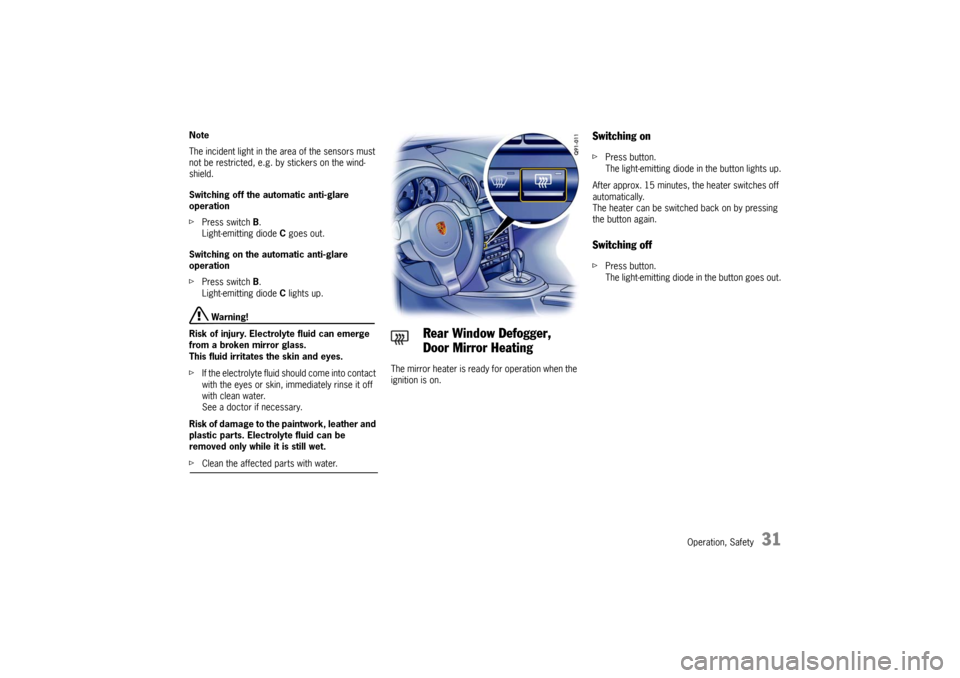
Operation, Safety
31
Note
The incident light in the area of the sensors must
not be restricted, e.g. by stickers on the wind-
shield.
Switching off the automatic anti-glare
operation
fPress switch B.
Light-emitting diode C goes out.
Switching on the automatic anti-glare
operation
f Press switch B.
Light-emitting diode C lights up.
Warning!
Risk of injury. Electrolyte fluid can emerge
from a broken mirror glass.
This fluid irritates the skin and eyes.
f If the electrolyte fluid should come into contact
with the eyes or skin, immediately rinse it off
with clean water.
See a doctor if necessary.
Risk of damage to the paintwork, leather and
plastic parts. Electrolyte fluid can be
removed only while it is still wet.
f Clean the affected parts with water. The mirror heater is ready for operation when the
ignition is on.
Switching on f
Press button.
The light-emitting diode in the button lights up.
After approx. 15 minutes, the heater switches off
automatically.
The heater can be switched back on by pressing
the button again.Switching off f Press button.
The light-emitting diode in the button goes out.
Rear Window Defogger,
Door Mirror Heating
Page 34 of 294

32
Operation, Safety
Seat Adjustment and Head
Restraints
Warning!
The seat may move unexpectedly if you
attempt to adjust while driving. This could
cause sudden loss of control, resulting in se-
rious personal injury or death.
f Do not adjust seats while the vehicle is in mo-
tion.
The backrest locks must be engaged at all
times while the vehicle is in motion.
Safety belts only offer protection when the
backrest is upright and the belts are properly
positioned on the body.
Improperly positioned sa fety belts or safety
belts worn by passengers in an excessively
reclined position can cause serious personal
injury or death in an accident.
f Do not operate the car with the driver or
passenger backrests excessively reclined
(see “Seat position”).
Risk of injury if persons or animals are in the
movement range of the seat during seat
adjustment.
f Adjust the seat so that no-one is put at risk.
Caution!
Risk of damage to windshield, sun visor, etc.
when the seat is adjusted or folded back or
forward.
f Adjust the seat so that the s e a t b a c k re s t i s n o t in contact with any other object.
The driver and passenger seats provide
integrated head restraints in the backrests. The
head restraints are not adjustable. Warning!
All occupants, including the driver, should not
operate a vehicle or sit in a vehicle's seat until the
head restraints and backrests, respectively, are
placed in their proper posi tions so that the risk of
neck injuries is minimize d in the event of a crash.
For proper positioning of the head restraint, the
seatback's inclination should be adjusted such
that the head restraint is in an upright position.
Driver and passenger should be seated upright
and in the center of their seats.
Seat positionAn ergonomically correct sitting position is
important for safe and fatigue-free driving.
We recommend the following procedure for adjust-
ing the driver’s seat to suit individual
requirements:
1. Vehicles with manual transmission:
Adjust the seat until, with the clutch pedal fully
depressed, your leg remains at a slight angle.
Vehicles with Porsche Doppelkupplung
(PDK):
Adjust the seat until, with your left foot on the
footrest, your left leg remains at a slight angle.
2. Rest your outstretched arm on the steering wheel.
Set the backrest angle (not applicable for
Sports bucket seat) and the steering-wheel
position so that your wr ist rests on the outer
rim of the steering wheel. At the same time,
the shoulders must still be in noticeable
contact with the backrest.
3. Adjust the seat height (not applicable for
Sports bucket seat) to give yourself enough
headroom and a good overview of the vehicle.
4. Electrically adjustable seat: Adjust the seat angle until your thighs rest
lightly on the seat cushion.
Page 37 of 294
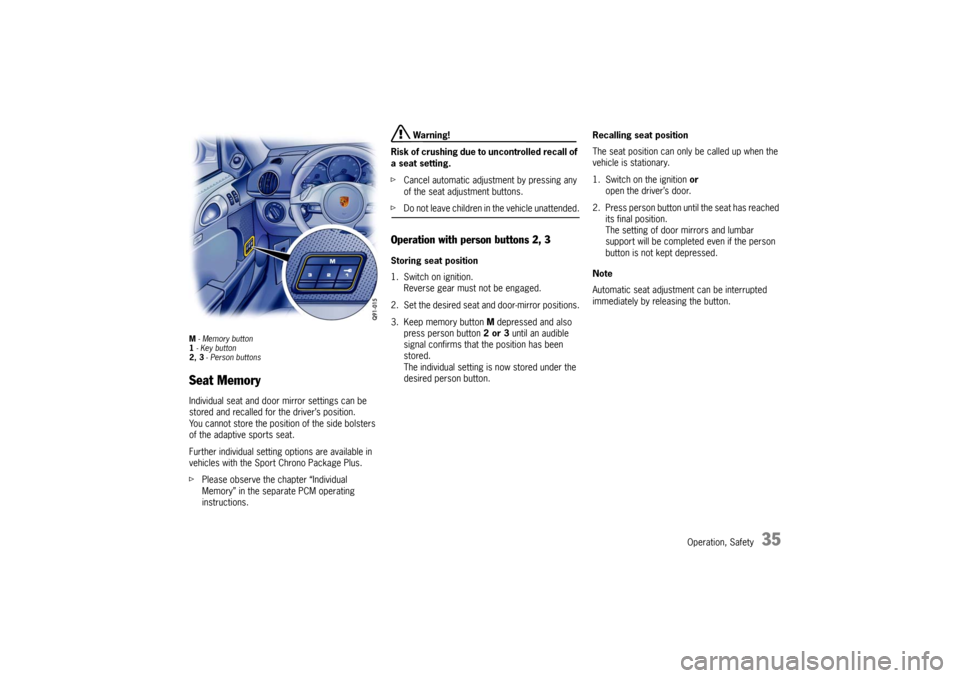
Operation, Safety
35
M - Memory button
1 - Key button
2, 3 - Person buttonsSeat MemoryIndividual seat and door mirror settings can be
stored and recalled for the driver’s position.
You cannot store the position of the side bolsters
of the adaptive sports seat.
Further individual setting options are available in
vehicles with the Sport Chrono Package Plus.
f Please observe the chapter “Individual
Memory” in the separate PCM operating
instructions.
Warning!
Risk of crushing due to uncontrolled recall of
a seat setting.
f Cancel automatic adjustment by pressing any
of the seat adjustment buttons.
fDo not leave children in the vehicle unattended.Operation with person buttons 2, 3Storing seat position
1. Switch on ignition.
Reverse gear must not be engaged.
2. Set the desired seat and door-mirror positions.
3. Keep memory button M depressed and also
press person button 2 or 3 until an audible
signal confirms that the position has been
stored.
The individual setting is now stored under the
desired person button. Recalling seat position
The seat position can only
be called up when the
vehicle is stationary.
1. Switch on the ignition or
open the driver’s door.
2. Press person button until the seat has reached its final position.
The setting of door mirrors and lumbar
support will be completed even if the person
button is not kept depressed.
Note
Automatic seat adjustment can be interrupted
immediately by releasing the button.